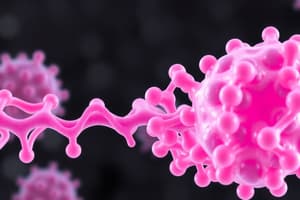Podcast
Questions and Answers
What is the primary structural feature of lipids?
What is the primary structural feature of lipids?
- Cyclic structure with multiple fatty acid tails
- Glycerol backbone with two fatty acid tails and a phosphate group (correct)
- Single fatty acid tail with a phosphate group
- Glycerol backbone with one fatty acid tail
What role do apolipoproteins play in lipoproteins?
What role do apolipoproteins play in lipoproteins?
- Act solely as energy storage molecules
- Serve as structural components of lipoproteins
- Function as carrier proteins and cofactors for enzymes (correct)
- Enable the digestion of lipids in the stomach
Which lipoprotein is known as 'bad cholesterol'?
Which lipoprotein is known as 'bad cholesterol'?
- VLDL
- LDL (correct)
- HDL
- IDL
What process involves the hydrolysis of triglycerides?
What process involves the hydrolysis of triglycerides?
What is a consequence of oxidative rancidity in triglycerides?
What is a consequence of oxidative rancidity in triglycerides?
Which statement about chylomicrons is true?
Which statement about chylomicrons is true?
What results from the hydrogenation of unsaturated fatty acids?
What results from the hydrogenation of unsaturated fatty acids?
Which lipoprotein is primarily responsible for removing cholesterol from the bloodstream?
Which lipoprotein is primarily responsible for removing cholesterol from the bloodstream?
Flashcards are hidden until you start studying
Study Notes
Lipids
- Lipids are composed of a glycerol backbone with two fatty acid tails and a phosphate group.
- They are arranged in a bilayer manner, with hydrophilic heads facing outwards and hydrophobic tails inwards.
Lipoproteins
- Lipoproteins are made of protein and fat, and carry cholesterol throughout the bloodstream.
- Their structure includes triglycerides, cholesterol, and phospholipids.
- Apolipoproteins function as carrier proteins and serve as cofactors for enzymes that metabolize lipoproteins.
Examples of Lipoproteins
- Chylomicrons: Large, triglyceride-rich lipoproteins produced in enterocytes from dietary lipids (fatty acids and cholesterol). They have the highest triglyceride content.
- VLDL: Very-low-density lipoproteins are made in the liver, have a high lipid concentration, and eventually become LDL.
- IDL: Intermediate-density lipoproteins form from the degradation of VLDL and HDL, and enable fat and cholesterol to move within the bloodstream, potentially promoting atheroma.
- LDL: Low-density lipoproteins are considered "bad cholesterol" as they are the main transporter of cholesterol.
- HDL: High-density lipoproteins are considered "good cholesterol" as they absorb cholesterol and carry it to the liver to be flushed from the body.
Chemical Properties of Lipids
- Hydrolysis of Triglycerides: Reaction with water to form carboxylic acid and alcohol.
- Saponification: Triacylglycerols are hydrolyzed (through alkaline hydrolysis) to produce soap.
- Hydrogenation: C-C double bonds in unsaturated fatty acids are hydrogenated to produce saturated fatty acids.
- Halogenation: Unsaturated fatty acids in fats and oils react with halogens through addition at the double bonds, leading to decolorization of the halogen solution.
- Rancidity: Fats develop a disagreeable odour due to hydrolysis and oxidation reactions. Oxidative rancidity occurs in triacylglycerols containing unsaturated fatty acids.
Lipid Profile Values
- Normal total cholesterol: 240 mg/dL
- HDL-C (good cholesterol) is increased when fasting for up to 12 hours before testing.
- HDL-C is associated with heart disease:
- For men, higher values indicate a lower risk.
- For women, higher values indicate a lower risk.
Studying That Suits You
Use AI to generate personalized quizzes and flashcards to suit your learning preferences.




